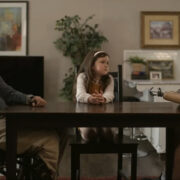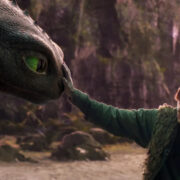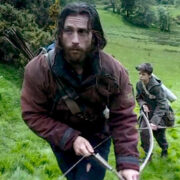Sheffield Doc/Fest 2019 Part 2: MIDNIGHT FAMILY, MIKE WALLACE IS HERE & More
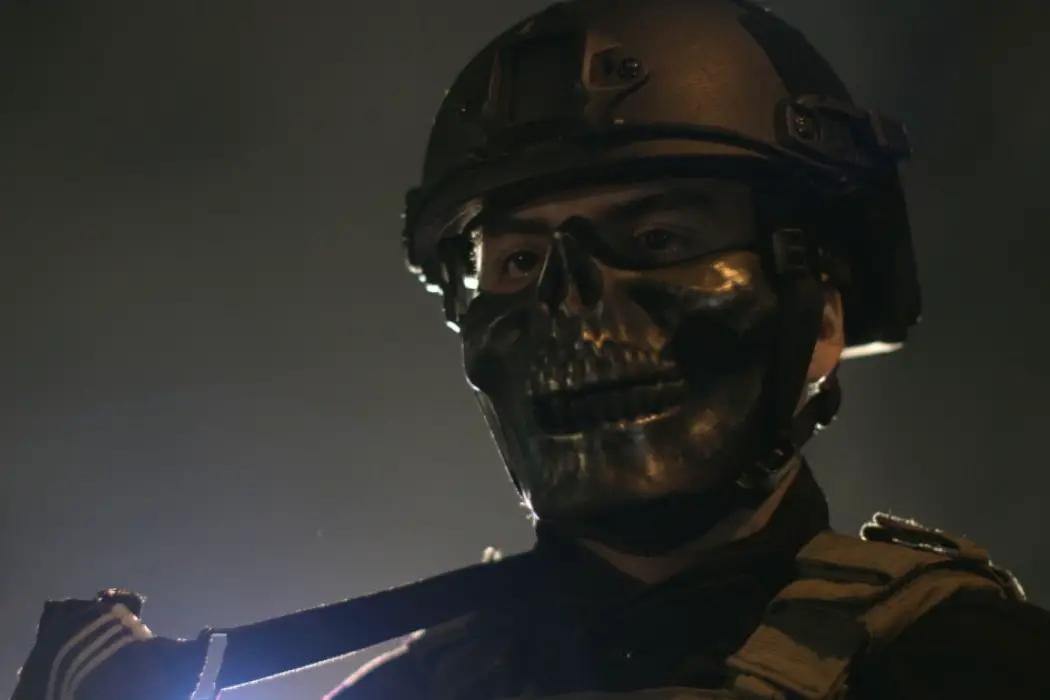
Musanna Ahmed is a freelance film critic writing for Film…
The second half of Sheffield Doc/Fest 2019 gave me three brilliant documentaries, two good ones, and one that was one of my least favourite in all of my three consecutive years at the festival. So, which ones are which? Well:
Midnight Family – Luke Lorentzen
Midnight Family is Guardians of the Galaxy in an ambulance. Obviously, I loved it.
I wasn’t familiar with the concept of this documentary beforehand: set in a wealthy neighbourhood of Mexico City, we follow the Ochoa family, who make a living as one of the family-run private ambulances competing with other for-profit EMT’s to take care of patients in emergencies. I wasn’t sure what kind of tonal tightrope such a narrative would walk on but I certainly didn’t expect it to remind me of the aforementioned Marvel movie. It’s similarly delightful and emotional, but naturally much more dramatic and vital.
The similarities come from the emotional ride of the viewing experience. Midnight Family is full of humour and sadness in its central characters’ arcs, who are a similarly entertaining medley of characters to the Guardians: a heroic family of medics who do good for moral reasons but also enticed by the monetary value, and that sometimes mean they have to stretch the truth about their labour. They say the sort of things Rocket Raccoon might say to score an extra buck, although here it feels like a necessary course of action considering the inequality of wealth, which has affected families like the Ochoas, as well as a defective healthcare system that this documentary shines a light on.
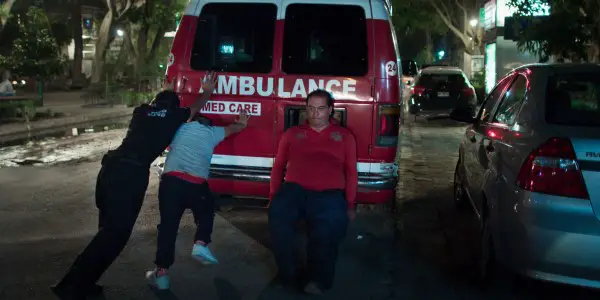
The Ochoas have a charismatic family dynamic; like the ragtag group of heroes on the planet Morag, their banter and commitment to each other come through strong despite the sheer intensity of their work. One such moment is in a speedy ambulance ride to the scene of an accident, where filmmaker Luke Lorentzen cuts to focus on the youngest child Josué playing with a ball, which reminded me of Groot playing with the detonator in the heat of the action during GOTG 2.
Dark humour comes from other moments like their sweary glee in beating an ambulance to the scene of an accident and Juan’s conversations on the phone with his girlfriend regarding privacy, or even simply light visual gags like a shirt that reads “It ain’t easy being cool but I manage”. Midnight Family doesn’t have the killer soundtrack of James Gunn‘s movies, it but has all the curse words Gunn wishes he could include in his script. Finally, the ambulance becoming a surrogate dwelling for the family as they spend long hours on the road can be likened to the homely spaceships inhabited by Starlord and co.
Anyway, away from the Guardians comparison, Midnight Family is outstanding alone for being one of the most remarkably filmed documentaries of the decade. Lorentzen’s placement of the few cameras within the ambulance captures stunning compositions that always facilitate his strong vérité storytelling whilst also looking fantastic.
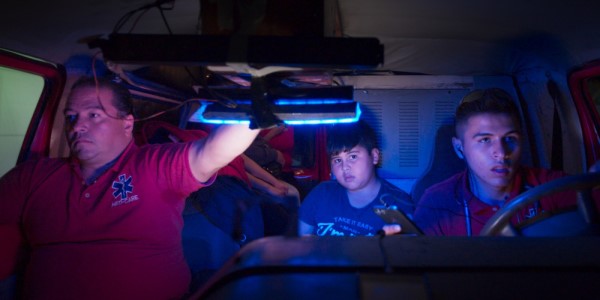
I haven’t been so impressed with the filming of a small space since Mohamed Diab‘s police van thriller Clash but the difference here is that there was no second takes. Having cut his teeth working on the magnificent Last Chance U, Lorentzen proves to be a master of observational filmmaking, and he has a great story with great characters here – it’s just surprising it hasn’t been covered much before considering its urgency. Midnight Family is an excellent portrait of a healthcare system in crisis and a subtle plea for change. It worthily took the Grand Jury Prize at the festival.
Cool Daddio: The Second Youth of R. Stevie Moore – Imogen Putler and Monika Baran
Cool Daddio: The Second Youth of R. Stevie Moore is fairly two-dimensional filmmaking of a three-dimensional character, and it almost feels flat on purpose due to the relative obscurity of the character and the need to tell his story in a straightforward way to reach the widest audience. R. Stevie Moore has been described as the great grandfather of lo-fi for his innovative, DIY, home-recorded, bedroom pop sound, and prolific musical output over the last four decades.
His unique, no-budget aesthetic could have been potentially mirrored in the style of the film for something exciting and dynamic but, to make it safe and perhaps less weird, the filmmakers choose to be rather traditional in their visual storytelling. This is a run-of-the-mill profile of the proto-hypnagogic pop legend, who can be especially appreciated now that his style is in vogue, as testified by contemporary musicians influenced by him including Theophilus London, Mac DeMarco, and his spiritual successor Ariel Pink.
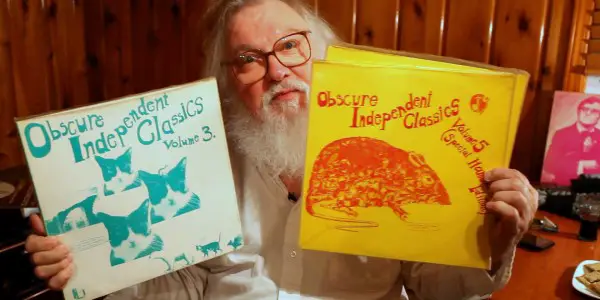
The most interesting dimension of this documentary is that R. Stevie Moore was ahead of his time, but would that time have come if it wasn’t for him? It begins as a typical appraisal of his career, with an assortment of artists praising his sounds and work ethic – the length of his discography makes Frank Zappa look like Frank Ocean – but when we reach the digital age, it becomes a surprisingly poignant rumination on finally achieving success and recognition.
There already has been a lot of drama in Moore’s life, particularly substance abuse, but following him in the present-day is melancholy because we see him struggling with age-related health issues during the most successful period of his life. After decades of being so close to breaking through but never making it, the advent of the internet and the instant connection it can provide artists to fans (resulting in a successfully crowd-funded tour) has been a saving grace for his relevance in spite of health difficulties, which have dramatically reduced his output.
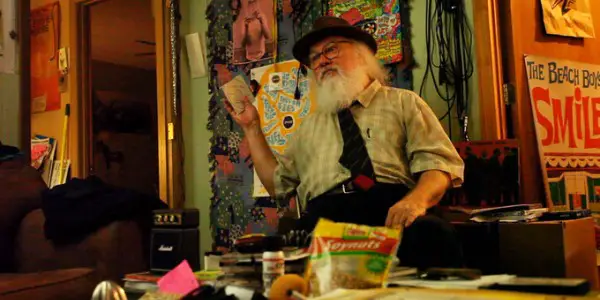
Spike Lee once spoke of “Kickstarting before Kickstarter” when he set up a campaign for Da Sweet Blood of Jesus – in the music world, R. Stevie Moore was Bandcamping before Bandcamp, through his home-based mailing service, the collection of which he still keeps. Though it’s less creative than its subject, Cool Daddio is a handy and surprisingly poignant guide to arguably lo-fi’s greatest pioneer. The flip-side of this documentary being so straightforward is that it’s accessible to those who may not even care about cassette culture.
On the President’s Orders – James Jones and Olivier Sarbil
Rodrigo Duterte’s own words comparing himself to Hitler have often been quoted when citing the controversial Philippines leader’s worst moments, and they never get any less queasier to listen to. We hear the infamous speech in the opening of On The President’s Orders, a well-rounded look at the President’s violent drug war from the perspective of a police unit in the city of Caloocan.
These cops are truly feared by the public, telling us how drug pushers were previously never bothered by their presence but now they’re all scared of the police. This can entirely be attributed not to their crackdown efforts but due to a President who’s given the authorities the green-light to kill on sight. The remorselessness shown by the police, and seeing them revel in scare tactics including gleefully threatening to kill as they interrogate and donning menacing skull masks, is what makes On the President’s Orders so chilling.
I kept waiting for a moment when one of them would hint at having some sort of conscience, like the climactic scene in The Act of Killing, but that moment never happens. The ceaseless loyalty to their president, a blind obedience to his policies, makes it all the more impossible to imagine that they have second thoughts about having arranged the deaths of individuals who weren’t even confirmed guilty, simply by picking names from a watch-list of thousands.
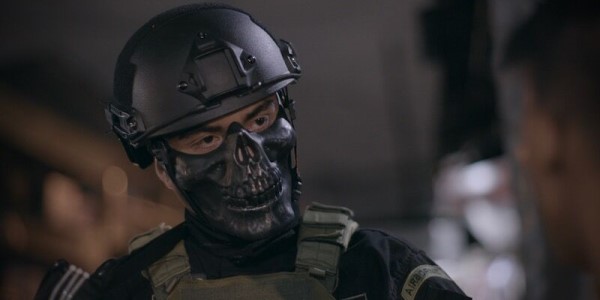
It can be argued that filmmakers James Jones and Olivier Sarbil made their film too early to realise such a moment, as Duterte continues to reign, but it’s necessary to bring this up-close point-of-view to the world’s attention right now, particularly as the International Criminal Court probes Duterte’s crimes against humanity. Furthermore, they certainly had to take advantage of the amazing access they gained by allowing to be embedded with this police unit. It’s somewhat evident that the subjects like the filmmakers more than the filmmakers like them, as the chiefs share incriminating info on camera, whilst the filmmakers remain cautious about cushioning their on-screen representation.
Handsomely mounted, On The President’s Orders shares the aesthetic of a Hollywood thriller, particularly the works of Michael Mann with the neon lights and busy nights. Despite being very well filmed, there are times when a shot doesn’t focus on the most valuable thing in a scene, and that may have been due to these international filmmakers working behind a language barrier (though a lot of contributors speak decent English), focusing on casually selected people and seeking their emotions, creating some meaning by lingering on faces and places. Sometimes it looks like B-roll, but it always looks good.
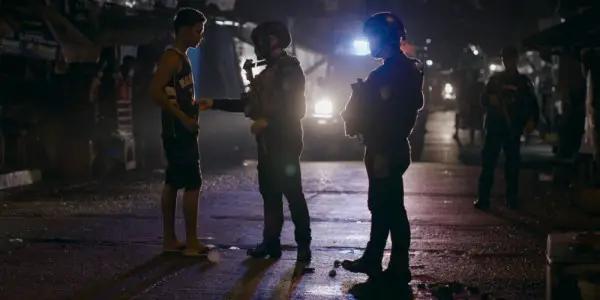
There comes a point where we stop gaining new insights or depth because the cops are too single-minded in their approach – we get the answers early about the truth behind extrajudicial killings. However, it’s still worthwhile for the directors to continue shooting as the war takes unpredictable turns, going from bad to worse in various motions but ending on a hopeful note, after leaders get expelled, protests gain traction, and the ICC kicks off an investigation. On the President’s Orders is the disturbing observational documentary we’ve needed about the Philippines drug war, made with finesse and astonishing access.
A Dog Called Money – Seamus Murphy
It was quite excruciating to watch A Dog Called Money, a legitimate test of my PJ Harvey fandom.
To start with, what I did enjoy about this otherwise inconsequential tripe was the kick I got from listening to the melodies come together for the songs of her last album, The Hope Six Demolition Project. This film, directed by award-winning photographer Seamus Murphy, is part travelogue, part recording session, and part self-indulgence.

Murphy’s lens follows the alt-rock artist travel around the world, particularly visiting parts that aren’t well off, including villages in Afghanistan and Kosovo, plus lower socio-economic areas of Washington D.C. As an audience member, it feels dangerously voyeuristic to accompany Harvey and Murphy; there’s little effort to properly appreciate or engage with the cultural experiences around them and it all feels like we’re observing them from her profitable perspective and his indulgent point-of-view, the latter of which sometimes even leads to plain boredom.
I wasn’t surprised to read the strong negative reactions to her song Community of Hope and I don’t imagine she has anything to vindicate herself for the offence she caused to the community of Ward 7 in D.C. Upon seeing the film, keeping in mind that it was competing for the Grand Jury Award, I had doubts that A Dog Called Money would win any awards or make even a little bit of impact but, in hindsight, it’s effective as an exposé of sorts – particularly one that reveals the artist’s dirty secrets to songwriting.
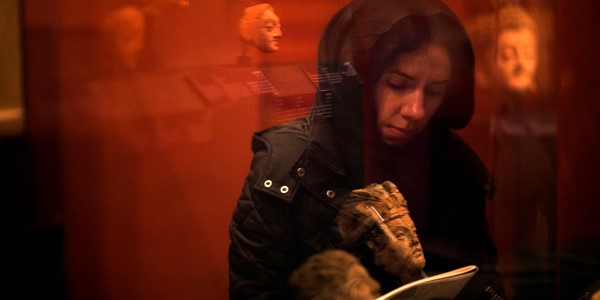
Listening to the album was once interesting, when I lacked context for the compositions, but this ignoble visual experience puts a damper on it. Regarding the communities subject to Murphy and Harvey’s gaze, maybe it’s possible that the process of making A Dog Called Money was dignified but it’s impossible to tell because of Murphy’s uncharacteristic choice to put aesthetic above purpose, presumably in the service of stepping out of the conventional biopic line for his first feature. A Dog Called Money certainly does look and play different to the average behind-the-scenes music doc but not for any discernible, compelling reason.
Mike Wallace Is Here – Avi Belkin
“Don’t confuse anger and hostility with insistence to get to the bottom line.” Mike Wallace’s interviewing style was seen by some guests as abrasive and by fellow journalists as “marvellous drama” but not good journalism. Avi Belkin‘s film about the legendary news correspondent, Mike Wallace Is Here, is both marvellous drama and good journalism.
Wallace was the one typically asking the questions, but he participated in just enough interviews to allow Belkin to delineate Wallace’ story using the reporter’s own words – the same narration method employed in Listen to Me Marlon, Tupac: Resurrection, Kurt Cobain: About a Son, etc. Wallace was one hell of a news correspondent, and his legacy could have been straightforwardly reflected on by interviewing his successors. But Belkin’s choice to avoid contributors and instead entirely use audio recordings is a much better, non-hagiographic way of getting to the heart of this inscrutable journalist.
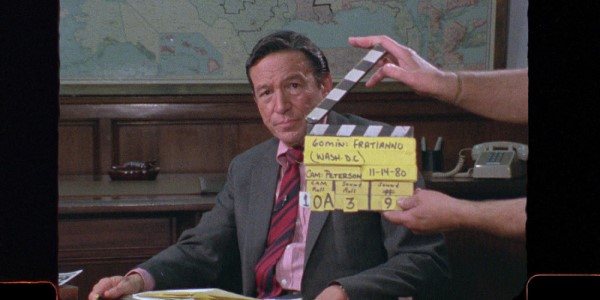
Over a fast-paced 90 minutes, we examine the life and the career of the legendary host of 60 Minutes. Naturally, there’s emphasis on the highest highs, including securing an exclusive interview with Ayatollah Khomeini and becoming the leading late night show, and the lowest lows, such as Westmoreland v. CBS, the libel suit brought in by former US Army General William Westmoreland and the death of his son Peter, both which took a deep emotional toll on him.
Not one to often let his guard down beyond giving a few revealing answers, the key to understanding Mike Wallace is through the values he places in his journalistic approach, which we gather by listening to him question his guests. His résumé as an interviewer features a murderers’ row of significant, famous individuals alive in his time, including Salvador Dali, Bette Davis, Eleanor Roosevelt, Drew Pearson, Rod Serling, MLK, Vladimir Putin, Barbra Streisand and many, many, many more. It’s fascinating to see how cantankerous guests could get when face-to-face with Wallace, yet they all wanted to speak to him anyway. That’s evidence of a consensus that he was the best investigative reporter of his time and they all knew it.
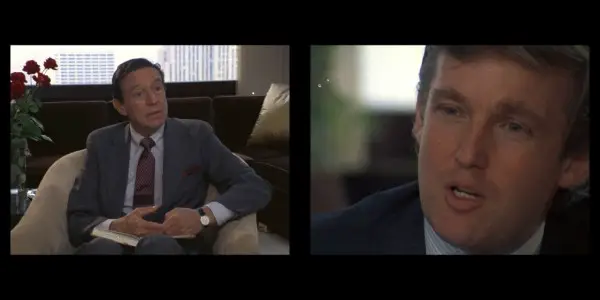
In Wallace’s own words, he didn’t stand up to defend the freedom of the press, but for people’s right to know the whole truth. Quotes like these strongly resonate today under an American government that curtails a free press. I can only hope that Mike Wallace Is Here is outdated in the future, if and when journalism returns to the strong form it took in Mike Wallace, and if and when presidents stop fostering a culture of propaganda and fake news.
It’s sad that post-Wallace journalism has spiralled into suck-ups and sensationalists, as encapsulated in the terrific opening scene where he interviews Bill O’Reilly, who credits Wallace for his style, whilst Wallace considers O’Reilly’s work to be closer to an op-ed columnist than a journalist. Mike Wallace was a brilliant investigative reporter, and this is a brilliant film to preserve his memory and remind us of the type of high-quality journalism that needs to be resurrected.
The Amazing Johnathan Documentary – Ben Berman
There’s been a growing appetite for twist docs over the past ten years or so, considering the success of Catfish, Three Identical Stranger, Tickled and The Imposter to name a few. The Amazing Johnathan Documentary enters this canon, and it may be the most twistiest one of them all.
Ben Berman’s documentary about The Amazing Johnathan is absolute magic. With such a startling number of twists and turns, this is rollercoaster cinema at its finest, and it’s also an amazing portrayal of a filmmaker being stuck in a creative rut and breaking out through persistence and ingenious artistry.
The surprises are plentiful – incalculable, even – so summarising the plot will be kept to a minimum. Basically, stand-up comedian and magician John Edward Szeles, better known by his stage name The Amazing Johnathan, was diagnosed some years ago with cardiomyopathy and told he only had a year to live, effectively forcing him into a quick retirement.
However, he managed to surpass the doctor’s expectations and continues to live. A few years after the announcement, against his doctor’s advice, he came out of retirement to embark on a big farewell tour. It’s at this point where Ben Berman begins The Amazing Johnathan Documentary, which begins as a traditional portrait of a dying magician, focusing on his personal life and utilising interviews with famous fans including “Weird Al” Yankovic, Eric Andre, and protégé Criss Angel.
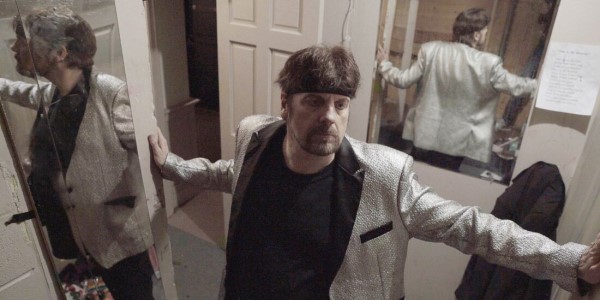
But after twenty minutes, approximately six months into filming, the first of many unexpected events takes Berman aback – Johnathan calls the filmmaker and dryly reveals that there’s a second documentary crew following him. To make things worse for Berman, the other crew are apparently behind two Oscar-winning documentaries, Searching for Sugar Man and Man on Wire – credentials that could grant a filmmaker access to anyone they want to make a film about.
What makes things even worse is that Johnathan gets increasingly coy about his availability to Berman as he’s enticed by the Academy Award-winning crew, so the filmmakers are pitted against each other as he relishes the attention. Berman is the underdog, and it’s easy to root for him because he’s genuinely passionate about completing his documentary and get connected to his emotional journey, which includes meeting his parents, and further because we learn more and more about the other crew and witness some shady tactics.
From this point on, The Amazing Johnathan Documentary is an out-an-out mystery, completely layered with questions on truth, deception and just what the hell this film is going to look like by the end. It’s a documentary within a documentary and then some, as Berman thinks he knows what he’s capturing on screen before an unforeseen reality distorts the image – multiple times. It’s kind of a massive stroke of luck for the filmmaker that his final cut is as spellbinding and unpredictable as the slippery subject himself, perfectly complementing the nature of a prankster, magician, illusionist.
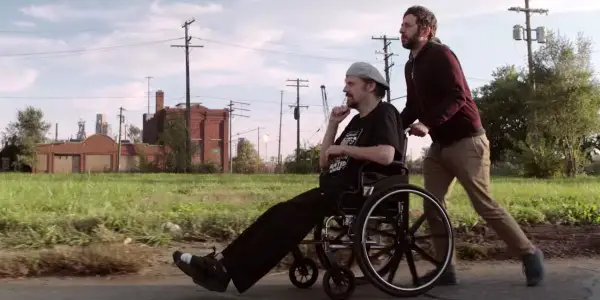
Berman’s comedy background already puts him at an advantage over anyone else trying to make a film about the Amazing Johnathan, because he demonstrates immaculate timing to make his film as funny and intriguing as possible, and the extent to which this documentary succeeds at being both is enormous. The editing is so on point, and even the title is brilliant – by simply titling the film The Amazing Johnathan Documentary – whilst the other documentary goes for something more cinematic – Berman has effortlessly won the SEO battle.
I don’t clap until the end of a film, but neither me nor my fellow patrons could stop ourselves from applauding multiple times throughout as this film won us over again and again with its dazzling narrative progression. The Amazing Johnathan Documentary is ingeniously constructed, a hilarious thrill ride and the underdog story of the year.
I was lucky it was the final film I saw over the six-day period because I would consider it my favourite film of Sheffield Doc/Fest 2019. All in all, I saw a great selection of films that engaged with social issues and the human condition in various riveting ways, and I’m excited for next year’s edition.
In Part 3, I will be taking a look at some of the offerings on the festival’s Doc/Player, provided to pass holders for a month after the end of the festival, which includes films such as the Mexican migration system doc Border South, Elizabeth Sankey’s deep dive on the history of rom-coms, aptly titled Romantic Comedy, and Hi, A.I., which looks like Spike Jonze’s Her as reality.
Does content like this matter to you?
Become a Member and support film journalism. Unlock access to all of Film Inquiry`s great articles. Join a community of like-minded readers who are passionate about cinema - get access to our private members Network, give back to independent filmmakers, and more.
Musanna Ahmed is a freelance film critic writing for Film Inquiry, The Movie Waffler and The Upcoming. His taste in film knows no boundaries.




